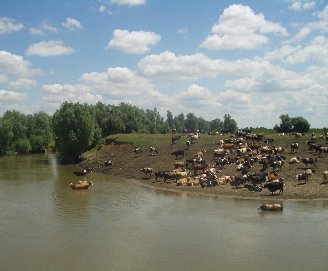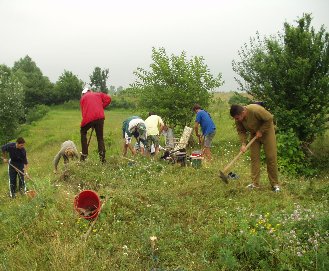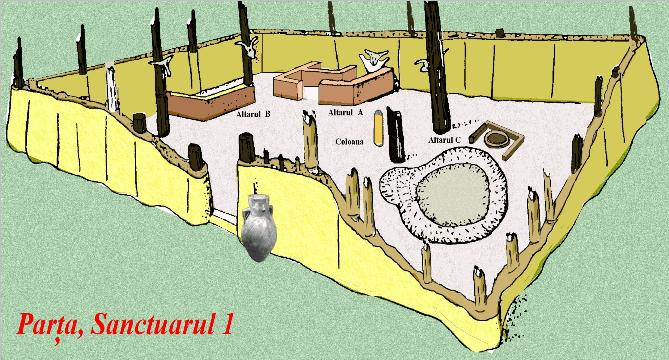

|
PARŢA archaeological
excavations
The deer house (Casa Cerbului) 1- 15 July 2005 TEAM: Gh. Lazarovici
(coordinator „Eftimie Murgu” University, Resita); Fl. Draşovean,
(Banat Museum Timisoara), Marco Merlini (vice-coordinator „Lucian
Blaga” University, Sibiu, EURO INNOVANET), Paola Uccelli Gnesutta
(Pisa University), Zoia Maxim (National Historical Museum of Transylvania,
Cluj-Napoca), Cornelia - Magda Lazarovici (Institute of Archaeology,
Iaşi), Valentin Cedică (Banat Museum Timisoara), Sorin
Petrescu, Dimitrie Negrei, Sorin Ioan, Daniela Gurgu (all from Ethnographical
and Border Regiment Museum, Caransebes), Cristian Roman, Dragos
Diaconescu (both from Castle Museum at Hunedoara), Angeleski Sote
(„Lucian Blaga” University, Sibiu), Oleg Chitic (Institute of Archaeology
and Ethnography, Chişinău), Tatar Arpad (Cluj), Tibi
Daroczy and Dobos Zenobia (students, Cluj University), Adrian Fota
(restorator at Banat Museum Timişoara), Diana Bindea, (paleozoologist
at National Historical Museum of Transylvania Cluj - Napoca), Bojin
Loredana and Burlacu Felicia (students, History-Theology Department,
Caransebeş).
CO-ORDINATING ORGANIZATIONS: EURO INNOVANET, Rome; Banat Museum, Timişoara.
Location (the excavation area: 45º 37’ 25’’N; 21º 06’50’’E; main sites: between 45º 37’ 10’’ and 45º 37’51’’N; between 21º 06’7’’ - 21º 07’08’’E). The settlement is located on the right bank of the Timis River, between the river dikes and westward, between an active river elbow and a meadow, in the place named „Saitos - La Vaci (fig. 1). In the first excavations the site had cca. 3-4 ha, but about 40% of it was destroyed by the river, or due to the construction of the river dikes. The first archaeological materials have been noticed with the occasion of the dikes’ construction. The site has been investigated by several important archaeologists: Joachim Miloja (1931) has excavated about 170 - 200 m2, and published an inventory and images with the discovered objects; M. Moga has made rescue excavations in 1943/1945, 1951 and in the period 1960-1963; he has investigated an area of 40 x 3 m (an anthropomorphic pot from his excavation is in fig. 21). Until now, we have investigated about 2100 m2; in some areas, the investigation has reached only the level 7c.
Several old riverbeds cross the settlement and water often overflows. In fact the archaeological area has over 50 Km2 and more than 42 sites (from Early Neolithic until Middle Age) or archaeological complexes (tumulus, pits, ovens) have been noticed. Many of the discoveries are accidental, related with plugging, fishing or flooding. Around the site of Parta gravitate other 14 sites and cult complexes, from the Early Neolithic until Copper Age period (Kupferzeit, from Tiszapolgár culture until Baden – Cotofeni cultures).
Two Neolithic sanctuaries have been discovered in the center of the site of Parţa: one with monumental statues that have been removed and reconstructed at Banat Museum, Timişoara; from the second sanctuary only the altar was preserved (table altar A). The additional presence of other sanctuaries, or household sanctuaries, as well as over 150 dwellings, 4 blocks of houses with 4 - 5 rooms, suspended floor or two levels suggests a very dynamic community. Over 30.000 objects have been discovered, out of which 20.000 have been selected and included in our database.
Two volumes and over 20 studies, reports and catalogues have been published. We have used interdisciplinary research, such as: magnetometry, pedologic analysis, paleozoologic investigation or analysis on pottery, tools (different sort of raw materials have been used), charcoal etc. |



